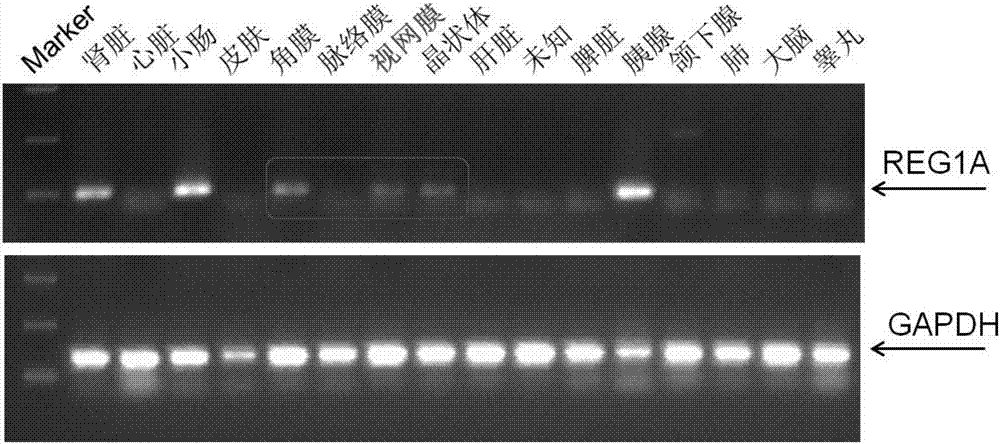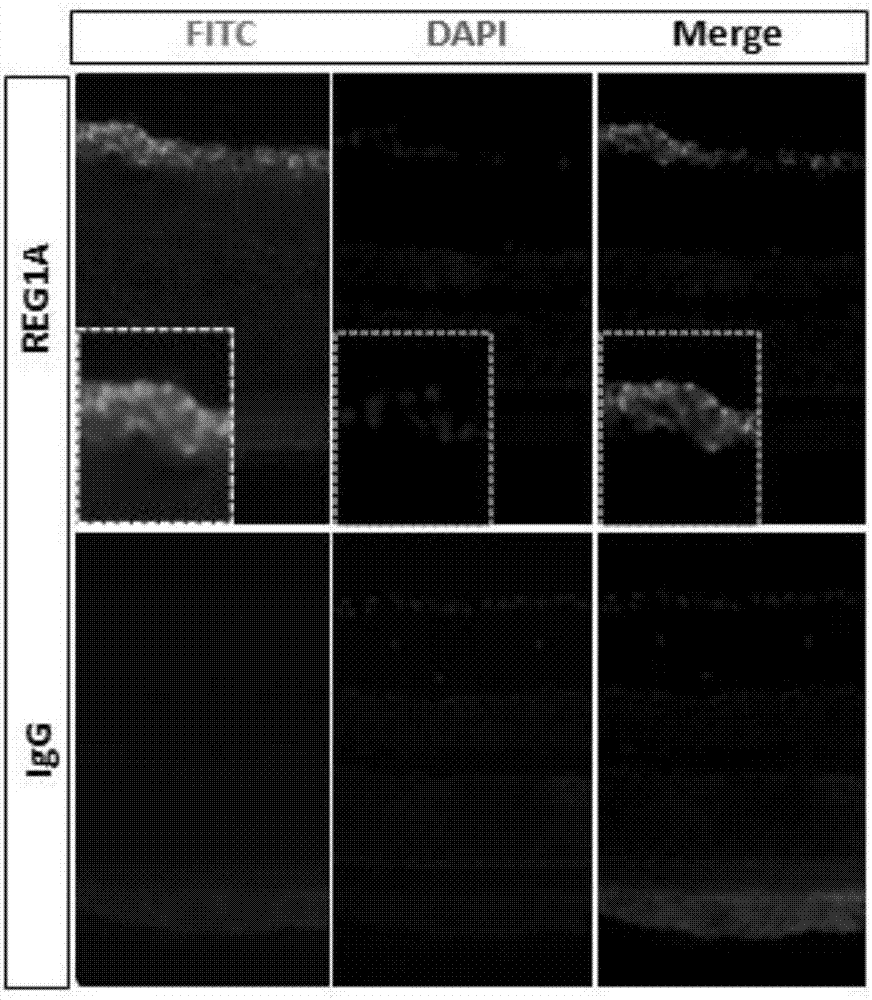Application of REG1A protein in preparation of drugs for treating and/or preventing retinal cell apoptosis
A retinal cell and protein technology, applied in the field of biomedicine, can solve problems such as chronic rejection, gene therapy mechanism cannot be fully clarified, patients' physical and psychological trauma, etc., and achieve the effect of small dosage and prevention of retinal degeneration
- Summary
- Abstract
- Description
- Claims
- Application Information
AI Technical Summary
Problems solved by technology
Method used
Image
Examples
Embodiment 1
[0038] Expression of neurosecretory factor reg1a gene in mouse retina
[0039] Various parts of mice were taken as experimental materials, including pancreas, kidney, heart, skin, small intestine tissue, brain, testis, choroid, liver, spleen, lung, subfrontal gland, cornea, retina and lens. The mRNA of each material was extracted from the above materials using the kit method.
[0040] After the quality of the extracted mRNA is tested, the mRNA with high integrity is subjected to semi-quantitative PCR detection. Specifically, a reverse transcription kit was used to reverse transcribe mRNA into cDNA, perform semi-quantitative PCR reaction on REG1A gene, and use GAPDH as an internal reference gene. The primer sequences of EG1A gene and mGAPDH are shown in Table 1, the PCR reaction system is shown in Table 2, and the PCR program is shown in Table 1. table 3.
[0041] Table 1 Primer sequences of REG1A gene and GAPDH
[0042]
[0043]
[0044] Table 2 PCR amplification syst...
Embodiment 2
[0051] Immunostaining steps:
[0052] Mouse retinas were dissected, fixed in 4% paraformaldehyde for 1 h, dehydrated with 15% and 30% glucose, embedded in OCT embedding medium, and frozen sections were prepared;
[0053] For washing, the retinal slices were put into DPBS, placed on a shaker and slowly rinsed 3 times, 5 minutes each time.
[0054] After rinsing, 500 μl of 0.5% TritonX-100 penetration solution prepared in DPBS was added to each well, and the cells were permeated for 10 minutes at room temperature, and the penetration solution was aspirated.
[0055] Repeat step 3, adding 500 μl of 3% HO in DPBS to each well 2 o 2 , 10min at room temperature to remove the influence of peroxidase.
[0056]Absorb H 2 o 2 , repeat step 3. Block with 4% BSA (prepared with DPBS) for 30 min at room temperature.
[0057] After aspirating the BSA, repeat step 3. Dilute the REG1A antibody at 1:100, add it to the culture dish, and incubate overnight at 4°C.
[0058] Recover the pr...
Embodiment 3
[0063] Expression and Purification of Recombinant REG1A Protein
[0064] The reg1a gene was subjected to agarose gel electrophoresis according to the PCR amplification method in Example 1 to obtain the reg1a gene fragment, and a large amount of reg1a gene fragments were obtained after gel recovery. Using the ligation kit, the recovered reg1a gene fragment was digested and ligated with the pET28a vector to obtain a recombinant vector. The recombinant vector was transformed into Escherichia coli strain BL-1, cultured on a shaker, and the cultured colonies were verified as positive bacteria by colony PCR. Add isopropylthiogalactopyranoside (IPTG) to the positive strains to induce expression, collect the bacteria by centrifugation, add buffer to make a suspension of bacteria, ultrasonically break, and collect the protein by centrifugation. Comparing the protein expression changes in bacteria before and after adding IPTG, the extracted protein was subjected to PAGE gel electrophor...
PUM
| Property | Measurement | Unit |
|---|---|---|
| concentration | aaaaa | aaaaa |
Abstract
Description
Claims
Application Information
 Login to View More
Login to View More - R&D
- Intellectual Property
- Life Sciences
- Materials
- Tech Scout
- Unparalleled Data Quality
- Higher Quality Content
- 60% Fewer Hallucinations
Browse by: Latest US Patents, China's latest patents, Technical Efficacy Thesaurus, Application Domain, Technology Topic, Popular Technical Reports.
© 2025 PatSnap. All rights reserved.Legal|Privacy policy|Modern Slavery Act Transparency Statement|Sitemap|About US| Contact US: help@patsnap.com



